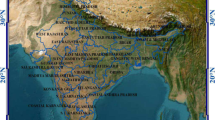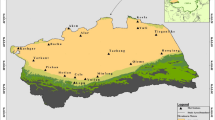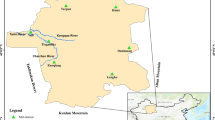Abstract
Drought is a multifaceted hydro-meteorological phenomenon that occurs due to a reduction in the amount of rainfall which increases complexity as well as scarcity in arid to semi-arid region. This research presented fluctuation in rainfall and analyzed drought conditions in Balochistan province using the standardized precipitation index (SPI). The six meteorological station (Met stations) data of rainfall were collected from the concerned stations. The data consists of 33 years of rainfall observations (1986–2018). For the data normality, skewness was applied and the results showed positive skewness at all station records with the highest variability in Kalat and Barkhan. The Mann–Kendall trend was applied on both 1-month and 12-month SPI data to assess the trend in the SPI results. In Balochistan, the SPI results detected two distinct driest drought intervals, i.e., 1998–2002 and 2014–2018. The MKT test results detected negative trend in the results of 1-month SPI at most of the selected stations with more significant results in Dalbandin. The January recorded a slight increase in rainfall in almost all weather stations with significant trend. Furthermore, the MKT results of the 12-month SPI deduced a significant positive trend in Dalbandin. Finally, the results revealed frequent drought events and it is expected that it may increase in the future.






Similar content being viewed by others
References
Adnan M, Rehman N, Sheikh M et al (2016) Influence of natural forcing phenomena on precipitation of Pakistan. Pak J Meteorol 12:23–35
Ahmad W, Fatima A, Awan UK et al (2014) Analysis of long term meteorological trends in the middle and lower Indus Basin of Pakistan—a non-parametric statistical approach. Glob Planet Chang 122:282–291
Ahmad S, Hussain Z, Qureshi AS, et al. (2004) Drought mitigation in Pakistan: current status and options for future strategies: IWMI
Ahmed K, Shahid S, Harun SB (2014) Spatial interpolation of climatic variables in a predominantly arid region with complex topography. Environ Syst Decis 34:555–563
Ahmed K, Shahid S, bin Harun S, et al (2016) Characterization of seasonal droughts in Balochistan province, Pakistan. Stoch Env Res Risk Assess 30:747–762
Ashraf M, Arshad A, Patel PM, et al. (2021) Quantifying climate-induced drought risk to livelihood and mitigation actions in Balochistan. Nat Hazards
Ashraf M, Routray JK (2013) Perception and understanding of drought and coping strategies of farming households in north-west Balochistan. Int J Disas Risk Reduc 5:49–60
Ashraf M, Routray JK (2015) Spatio-temporal characteristics of precipitation and drought in Balochistan province, Pakistan. Nat Hazards 77:229–254
Ashraf M (2016) Managing water scarcity in Pakistan: moving beyond rhetoric. AASSA-PAS regional workshop on challenges in water security to meet the growing food requirement. Islamabad: Pakistan Academy of Sciences, 3–14
Dai A (2011) Drought under global warming: a review. Wiley Interdiscip Rev Clim Chang 2:45–65
Dawood M, Mahmood S, Rahman G et al (2017) Impact of rainfall fluctuation on river discharge in Hindu Kush region, Pakistan. Abasyn J Soc Sci 10:246–259
Dawood M, Rahman A, Ullah S et al (2018) Spatio-temporal analysis of temperature variability, trend, and magnitude in the Hindu Kush region using Monte Carlo and Sen’s slope approaches. Arab J Geosci 11:471
Dawood M, Rahman A-u, Ullah S et al (2020) Spatio-statistical analysis of rainfall fluctuation, anomaly and trend in the Hindu Kush region using ARIMA approach. Nat hazard 101:1–16
Dawood M, Rahman A-u, Mahmood S et al (2021) Assessing the impact of climatic change on discharge in Swat river basin using fuzzy logic model. Arab J Geosci 14:1–16
Dracup KJA (2002) The quantification of drought: an evaluation of drought indices. Bull Am Meteor Soc 83:1167–1180
ElNesr MN, Abu-Zreig, et al (2010) Temperature trends and distribution in the Arabian Peninsula. Am J Environ Sci 6:191–203
Field CB, Barros V, Stocker TF, et al. (2012) Managing the risks of extreme events and disasters to advance climate change adaptation: special report of the intergovernmental panel on climate change: Cambridge University Press
Hayes MJ, Svoboda MD, Wiihite DA et al (1999) Monitoring the 1996 drought using the standardized precipitation index. Bull Am Meteor Soc 80:429–438
He Y, Zhang Y (2005) Climate change from 1960 to 2000 in the Lancang River Valley, China. Mt Res Dev 25:341–348
Jemai S, Kallel A, Abida H (2018) Drought distribution using the standardized precipitation index: case of Gabes Basin. South Tunis Arab J Geosci 11:737
Jin H, Yan X, Sun S et al (2015) Spatial and temporal variability of drought during 1960–2012 in Inner Mongolia, North China. Quatern Int 355:134–144
Khan N, Sachindra D, Shahid S et al (2020) Prediction of droughts over Pakistan using machine learning algorithms. Adv Water Resour 139:103562
Khan N, Shahid S, Chung E-S et al (2020b) Spatiotemporal changes in precipitation extremes in the arid province of Pakistan with removal of the influence of natural climate variability. Theor Appl Climatol 142:1447–1462
Loon AFV, Laaha G (2015) Hydrological drought severity explained by climate and catchment characteristics. J Hydrol 526:3–14
Manatsa D, Chingombe W, Matsikwa H et al (2008) The superior influence of Darwin sea level pressure anomalies over ENSO as a simple drought predictor for Southern Africa. Theor Appl Climatol 92:1–14
McKee TB, Doesken NJ and Kleist J. (1993) The relationship of drought frequency and duration to time scales. Proceedings of the 8th conference on applied climatology. American meteorological society Boston, 179–183
Modarres R (2007) Rainfall trends in arid and semi-arid regions of Iran. J Arid Environ 70:344–355
Mustafa A, Rahman G (2018) Assessing the spatio-temporal variability of meteorological drought in Jordan. Earth Syst Environ 2:247–264
Naz F, Dars GH, Ansari K et al (2020) Drought trends in Balochistan. Water 12:470
Ofipcc WGI (2013) Climate change; the physical science basis. Contrib Work 43:866–871
Park CE, Jeong SJ, Joshi M et al (2018) Keeping global warming within 1.5 °C constrains emergence of aridification. Nat Clim Chang 8:70–74
Qureshi AS and Akhtar M (2004) Analysis of drought-coping strategies in Baluchistan and Sindh provinces of Pakistan: IWMI
Rad AM, Ghahraman B, Khalili D, et al. (2016) Integrated meteorological and hydrological drought model: a management tool for proactive water resources planning of semi-arid regions. Adv Water Resour 107
Rahman G, Rahman A, Samiullah, et al (2018) Spatial and temporal variation of rainfall and drought in Khyber Pakhtunkhwa province of Pakistan during 1971–2015. Arab J Geosci 11:1–13
Rahman G, Rahman A-u, Ullah S et al (2021) Spatio-temporal characteristics of meteorological drought in Khyber Pakhtunkhwa, Pakistan. Plos One 16:1–16
Rasul G, Mahmood A, Sadiq A, et al. (2012) Vulnerability of the Indus delta to climate change in Pakistan. Pak J Meteorol 8
Shafiq M, Kakar M (2007) Effects of drought on livestock sector in Balochistan province of Pakistan. Int J Agric Biol 9:657–665
Sheffield J, Wood EF (2007) Characteristics of global and regional drought, 1950–2000: analysis of soil moisture data from off-line simulation of the terrestrial hydrologic cycle. J Geophys Res Atmos 112:D17115
Stagge JH, Tallaksen LM, Gudmundsson L et al (2015) Candidate distributions for climatological drought indices (SPI and SPEI). Int J Climatol 35:4027–4040
Tabari H, Marofi S, Aeini A et al (2011) Trend analysis of reference evapotranspiration in the western half of Iran. Agric Forest Meteorol 151:0–136
Tfwala C, van Rensburg L, Schall R et al (2018) Drought dynamics and interannual rainfall variability on the Ghaap plateau, South Africa, 1918–2014. Phys Chem Earth A B C 107:1–7
Touma D, Ashfaq M, Nayak MA et al (2015) A multi-model and multi-index evaluation of drought characteristics in the 21st century. J Hydrol 526:196–207
Ullah I, Yuanjie Z, Ali S et al (2020) Rainfall and drought variability in spatial and temporal context in Lop Nor region, South Xinjiang, China, during 1981–2018. Arab J Geosci 13:1–13
Xie H, Ringler C, Zhu T et al (2013) Droughts in Pakistan: a spatiotemporal variability analysis using the standardized precipitation index. Water Int 38:620–631
Zhang Q, Li J, Singh VP et al (2012) SPI-based evaluation of drought events in Xinjiang, China. Nat Hazards 64:481–492
Funding
This study is supported by the National Natural Science Foundation of China (Grant Nos. 41877433) and the Hebei Natural Science Foundation and Key Basic Research (18963301D).
Author information
Authors and Affiliations
Corresponding author
Ethics declarations
Conflict of interest
The authors declare no competing interests.
Additional information
Responsible Editor: Amjad Kallel
Rights and permissions
About this article
Cite this article
Rafiq, M., Li, Y.C., Cheng, Y. et al. Spatial and temporal fluctuation of rainfall and drought in Balochistan province, Pakistan. Arab J Geosci 15, 214 (2022). https://doi.org/10.1007/s12517-022-09514-4
Received:
Accepted:
Published:
DOI: https://doi.org/10.1007/s12517-022-09514-4




